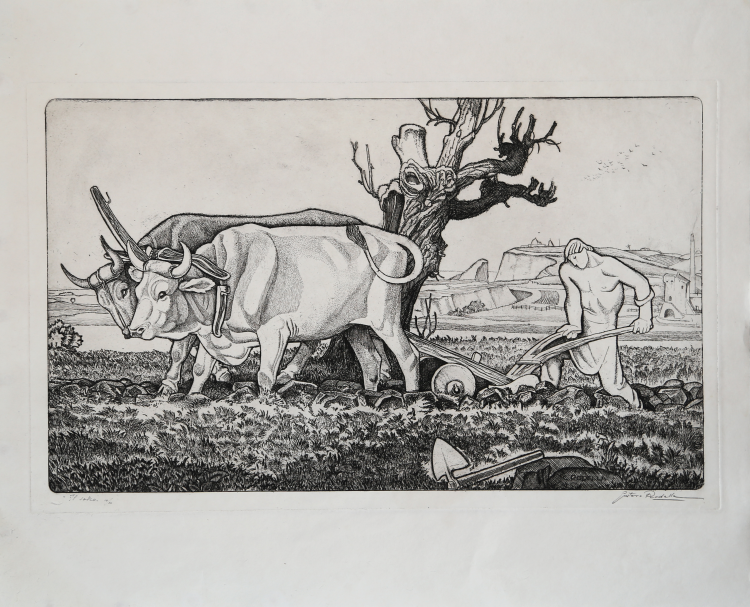


| Reference: | S42084 |
| Author | Gustavo RODELLA |
| Year: | 1930 ca. |
| Measures: | 500 x 315 mm |


| Reference: | S42084 |
| Author | Gustavo RODELLA |
| Year: | 1930 ca. |
| Measures: | 500 x 315 mm |
Etching, circa 1930, signed in plate at lower right. Title written in pencil at lower left, signed in pencil at lower right Gustavo Rodella. Limited edition of 30 copies, proof 14/30.
Magnificent proof, printed on contemporary Japanese paper, with margins, in perfect condition.
Gustavo RODELLA (Roma, 15 agosto 1891 – 1937)
|
Gustavo Rodella was the son of Ottavio, a painter specialized in military subjects, and Angela Canonica. After the bankruptcy of the publishing company for which his father worked, the whole family moved to Milan, where Gustavo enrolled and graduated from the Brera Academy. Gustavo Rodella moved to Rome in 1912 and opened a studio in Via Margutta.
In 1913 he debuted at an exhibition of the Association of Amateurs and Connoisseurs of Fine Arts and in 1929 he obtained the chair of Engraving Techniques at the Academy of Fine Arts in Rome. He used various types of engraving: the woodcut, etching, aquatint, soft paint, drypoint and lithography. He was one of the 25 founders of the Gruppo Romano Incisori Artisti (Gria), established in Palazzo Venezia, Rome, on the initiative of Federico Hermanin. Realized the watercolor figurines and winking ladies, engraved views of Rome in etching or aquatint, such as the Church of San Carlo alle Quattro Fontane. He designed covers for the "Giornalino della Domenica". Another engraving, popular, represents the preparations for an execution of the Roman executioner Mastro Titta, in Piazza del Popolo. Engraving verista is Le Gerle, of 1909; an aquatint of symbolist taste is The Tree of Villa d'Este, of 1932. He took part in about seventy exhibitions, including the exhibition of Colonial Rome, the exhibitions of Black and White Milan and Florence, the Exposition of Figurative Art in Turin and exhibitions in New York, Buenos Aires and Los Angeles in 1923, Chicago in 1931, Bordeaux in 1932, Warsaw and Vienna in 1933, in Monaco in 1934.
A series of 32 plates, engraved with different techniques, was donated in 1973 by the artist's sister Rosalia Rondella Vichi to the Istituto Nazionale per la Grafica, which was then called Calcografia Nazionale and was directed by Carlo Bertelli.
|
Gustavo RODELLA (Roma, 15 agosto 1891 – 1937)
|
Gustavo Rodella was the son of Ottavio, a painter specialized in military subjects, and Angela Canonica. After the bankruptcy of the publishing company for which his father worked, the whole family moved to Milan, where Gustavo enrolled and graduated from the Brera Academy. Gustavo Rodella moved to Rome in 1912 and opened a studio in Via Margutta.
In 1913 he debuted at an exhibition of the Association of Amateurs and Connoisseurs of Fine Arts and in 1929 he obtained the chair of Engraving Techniques at the Academy of Fine Arts in Rome. He used various types of engraving: the woodcut, etching, aquatint, soft paint, drypoint and lithography. He was one of the 25 founders of the Gruppo Romano Incisori Artisti (Gria), established in Palazzo Venezia, Rome, on the initiative of Federico Hermanin. Realized the watercolor figurines and winking ladies, engraved views of Rome in etching or aquatint, such as the Church of San Carlo alle Quattro Fontane. He designed covers for the "Giornalino della Domenica". Another engraving, popular, represents the preparations for an execution of the Roman executioner Mastro Titta, in Piazza del Popolo. Engraving verista is Le Gerle, of 1909; an aquatint of symbolist taste is The Tree of Villa d'Este, of 1932. He took part in about seventy exhibitions, including the exhibition of Colonial Rome, the exhibitions of Black and White Milan and Florence, the Exposition of Figurative Art in Turin and exhibitions in New York, Buenos Aires and Los Angeles in 1923, Chicago in 1931, Bordeaux in 1932, Warsaw and Vienna in 1933, in Monaco in 1934.
A series of 32 plates, engraved with different techniques, was donated in 1973 by the artist's sister Rosalia Rondella Vichi to the Istituto Nazionale per la Grafica, which was then called Calcografia Nazionale and was directed by Carlo Bertelli.
|